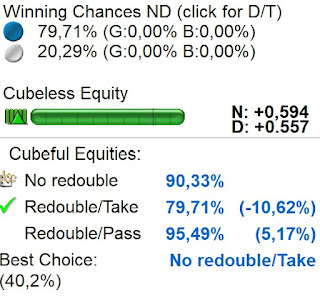Backgammon is not one game, but three games with increasing difficulty level.
LEVEL 1: matches to one point
You and your opponent roll the dice, move the checkers until one of you have won. It’s a tricky game already, with very different strategies to cover holding games, back games and such. If you master it well you’re ready for…
LEVEL 2: money games
Enters the doubling cube, maybe the most fiendish device created in any board game. Before every single move you must estimate whether you are more than 75% likely to win the game, and whether this assessment is likely to change next move.
I’m fairly good at level 1, regularly play on “advanced” level. But after years of backgammon my cube handling is still on “beginner” level. Sometimes I do well, sometimes I fail completely.
LEVEL 3: matches
Once you believe you have mastered the cube, proceed to level 3 and play matches. And all of a sudden, much changes. You play differently if you’re leading or if you’re far behind, and the cube’s value changes madly.
Yesterday (that’s why I’m writing this today :-) ) I reviewed a match I played on DailyGammon and came across this position:
Blue's move. Cube action? Redouble or play?
This is a match to 20 points (yeah, really), I'm leading 13:5. I hold the cube at 4, can redouble to 8. What should I do?
On level 2, this is an easy double. I need three rolls to bear off my checkers, he needs 3 rolls to bear off his checkers.
So I doubled. And XG tells me "you were a really, really, REALLY dumb fool doubling." (okay it tells me I lost a full 0.83 points of equity, which (assuming a blunder costs you 0.08 points) is a tenfold blunder.
At the same time XG confirms that I was correct with my "level 2" assessment: I'm 80% likely to win this game, so I should double, and white should pass.
Money game analysis - redouble/pass
But the thing is: I'm leading 13:5, and I'm 80% likely to end this match leading 17:5. XG says that in this situation I'm 90% likely to win the match before doubling. If I double to 8, white will redouble to 60. making this a "double match point". And as the figure above says: I'm 80% likely to win this match, so I reduced my match winning changes from 90% to 80% by doubling. Good move.
Match analysis (using match winning changes instead of equity)
Much left to learn to master level 3, the match play.












